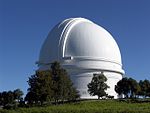Rancho San José del Valle
California ranchosRanchos of San Diego County, CaliforniaWarner Springs, California
Rancho San José del Valle (also called "Rancho Agua Caliente" or "Warner's Rancho") was a 26,689-acre (108.01 km2) Mexican land grant in present-day San Diego County, California given in 1840 by Governor Juan B. Alvarado to José Antonio Pico, and then given in 1844 by Governor Manuel Micheltorena to Juan José Warner. The most northeasterly grant made within present-day San Diego County, it was bounded on the west by Palomar Mountain, and on the south by Buena Vista Creek and Rancho Valle de San Jose, and encompassed present-day Warner Springs. The western part of the grant is under the waters of Lake Henshaw, formed in 1922 by a dam on the San Luis Rey River.
Excerpt from the Wikipedia article Rancho San José del Valle (License: CC BY-SA 3.0, Authors).Rancho San José del Valle
Highway 79,
Geographical coordinates (GPS) Address Nearby Places Show on map
Geographical coordinates (GPS)
| Latitude | Longitude |
|---|---|
| N 33.29 ° | E -116.68 ° |
Address
Highway 79
Highway 79
92086
California, United States
Open on Google Maps



